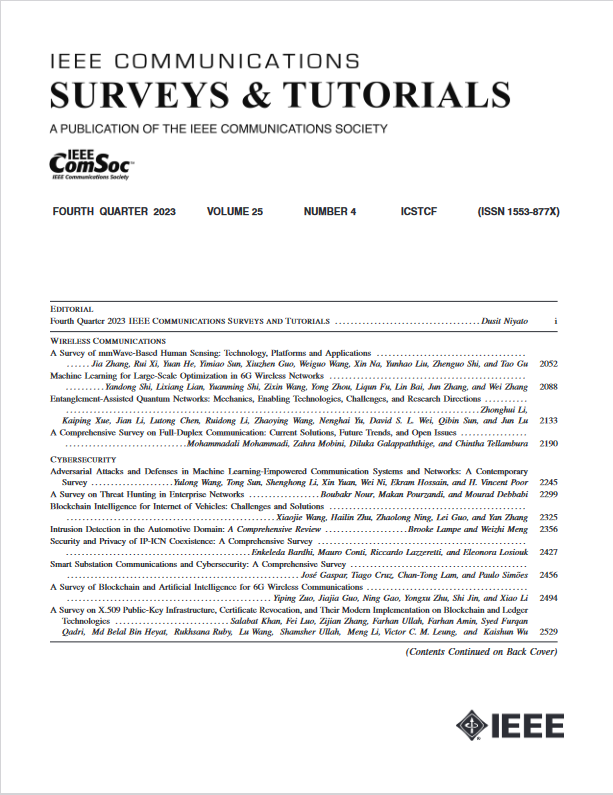语义驱动的通信:教程与调查
IF 34.4
1区 计算机科学
Q1 COMPUTER SCIENCE, INFORMATION SYSTEMS
引用次数: 0
摘要
随着语义赋能通信(SemCom)研究的兴起,学术界和产业界对其各个方面(如理论、应用、度量和实现)的兴趣空前高涨。在这项工作中,我们的主要目标是对背景和研究分类进行全面调查,并提供详细的技术教程。具体来说,我们首先回顾文献,回答语义传输中 "是什么 "和 "为什么 "的问题。随后,我们介绍了 SemCom 的生态系统,包括历史、理论、度量标准、数据集和工具包,并在此基础上提出了研究方向分类法。此外,我们还建议按照基于显式和隐式推理的方法对关键的使能技术进行分类,并详细说明这些技术是如何发展和促进现代内容与通道语义赋能通信的。除了回顾和总结 SemCom 的最新成果,我们还从整体和统一的角度讨论了与其他通信层面(如传统通信)的关系。随后,为了促进未来的发展和行业应用,我们还重点介绍了提高语义准确性、鲁棒性和大规模可扩展性的先进实用技术。最后,我们讨论了技术挑战,为未来的研究机会提供了启示。本文章由计算机程序翻译,如有差异,请以英文原文为准。
Semantics-Empowered Communications: A Tutorial-Cum-Survey
Along with the springing up of the semantics-empowered communication (SemCom) research, it is now witnessing an unprecedentedly growing interest towards a wide range of aspects (e.g., theories, applications, metrics and implementations) in both academia and industry. In this work, we primarily aim to provide a comprehensive survey on both the background and research taxonomy, as well as a detailed technical tutorial. Specifically, we start by reviewing the literature and answering the “what” and “why” questions in semantic transmissions. Afterwards, we present the ecosystems of SemCom, including history, theories, metrics, datasets and toolkits, on top of which the taxonomy for research directions is presented. Furthermore, we propose to categorize the critical enabling techniques by explicit and implicit reasoning-based methods, and elaborate on how they evolve and contribute to modern content & channel semantics-empowered communications. Besides reviewing and summarizing the latest efforts in SemCom, we discuss the relations with other communication levels (e.g., conventional communications) from a holistic and unified viewpoint. Subsequently, in order to facilitate future developments and industrial applications, we also highlight advanced practical techniques for boosting semantic accuracy, robustness, and large-scale scalability, just to mention a few. Finally, we discuss the technical challenges that shed light on future research opportunities.
求助全文
通过发布文献求助,成功后即可免费获取论文全文。
去求助
来源期刊

IEEE Communications Surveys and Tutorials
COMPUTER SCIENCE, INFORMATION SYSTEMS-TELECOMMUNICATIONS
CiteScore
80.20
自引率
2.50%
发文量
84
审稿时长
6 months
期刊介绍:
IEEE Communications Surveys & Tutorials is an online journal published by the IEEE Communications Society for tutorials and surveys covering all aspects of the communications field. Telecommunications technology is progressing at a rapid pace, and the IEEE Communications Society is committed to providing researchers and other professionals the information and tools to stay abreast. IEEE Communications Surveys and Tutorials focuses on integrating and adding understanding to the existing literature on communications, putting results in context. Whether searching for in-depth information about a familiar area or an introduction into a new area, IEEE Communications Surveys & Tutorials aims to be the premier source of peer-reviewed, comprehensive tutorials and surveys, and pointers to further sources. IEEE Communications Surveys & Tutorials publishes only articles exclusively written for IEEE Communications Surveys & Tutorials and go through a rigorous review process before their publication in the quarterly issues.
A tutorial article in the IEEE Communications Surveys & Tutorials should be designed to help the reader to become familiar with and learn something specific about a chosen topic. In contrast, the term survey, as applied here, is defined to mean a survey of the literature. A survey article in IEEE Communications Surveys & Tutorials should provide a comprehensive review of developments in a selected area, covering its development from its inception to its current state and beyond, and illustrating its development through liberal citations from the literature. Both tutorials and surveys should be tutorial in nature and should be written in a style comprehensible to readers outside the specialty of the article.
 求助内容:
求助内容: 应助结果提醒方式:
应助结果提醒方式:


